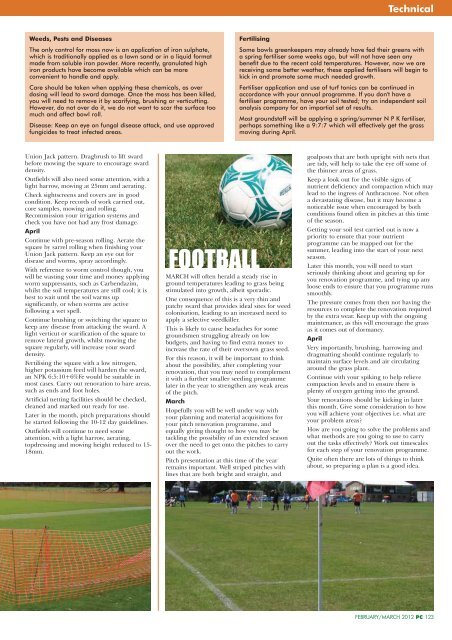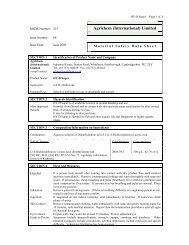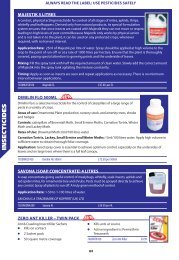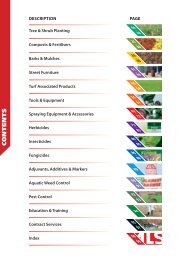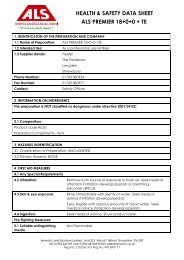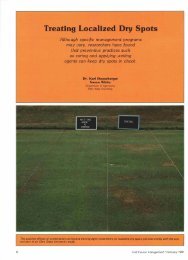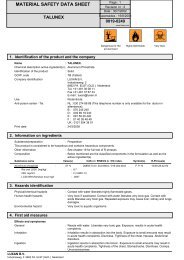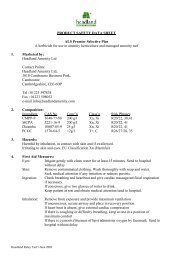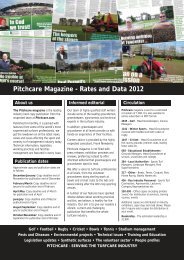these Open Championship Clubs choose to relief grind - Pitchcare
these Open Championship Clubs choose to relief grind - Pitchcare
these Open Championship Clubs choose to relief grind - Pitchcare
Create successful ePaper yourself
Turn your PDF publications into a flip-book with our unique Google optimized e-Paper software.
Weeds, Pests and Diseases<br />
The only control for moss now is an application of iron sulphate,<br />
which is traditionally applied as a lawn sand or in a liquid format<br />
made from soluble iron powder. More recently, granulated high<br />
iron products have become available which can be more<br />
convenient <strong>to</strong> handle and apply.<br />
Care should be taken when applying <strong>these</strong> chemicals, as over<br />
dosing will lead <strong>to</strong> sward damage. Once the moss has been killed,<br />
you will need <strong>to</strong> remove it by scarifying, brushing or verticutting.<br />
However, do not over do it, we do not want <strong>to</strong> scar the surface <strong>to</strong>o<br />
much and affect bowl roll.<br />
Disease: Keep an eye on fungal disease attack, and use approved<br />
fungicides <strong>to</strong> treat infected areas.<br />
Union Jack pattern. Dragbrush <strong>to</strong> lift sward<br />
before mowing the square <strong>to</strong> encourage sward<br />
density.<br />
Outfields will also need some attention, with a<br />
light harrow, mowing at 25mm and aerating.<br />
Check sightscreens and covers are in good<br />
condition. Keep records of work carried out,<br />
core samples, mowing and rolling.<br />
Recommission your irrigation systems and<br />
check you have not had any frost damage.<br />
April<br />
Continue with pre-season rolling. Aerate the<br />
square by sarrel rolling when finishing your<br />
Union Jack pattern. Keep an eye out for<br />
disease and worms, spray accordingly.<br />
With reference <strong>to</strong> worm control though, you<br />
will be wasting your time and money applying<br />
worm suppressants, such as Carbendazim,<br />
whilst the soil temperatures are still cool; it is<br />
best <strong>to</strong> wait until the soil warms up<br />
significantly, or when worms are active<br />
following a wet spell.<br />
Continue brushing or switching the square <strong>to</strong><br />
keep any disease from attacking the sward. A<br />
light verticut or scarification of the square <strong>to</strong><br />
remove lateral growth, whilst mowing the<br />
square regularly, will increase your sward<br />
density.<br />
Fertilising the square with a low nitrogen,<br />
higher potassium feed will harden the sward,<br />
an NPK 6:5:10+6%Fe would be suitable in<br />
most cases. Carry out renovation <strong>to</strong> bare areas,<br />
such as ends and foot holes.<br />
Artificial netting facilities should be checked,<br />
cleaned and marked out ready for use.<br />
Later in the month, pitch preparations should<br />
be started following the 10-12 day guidelines.<br />
Outfields will continue <strong>to</strong> need some<br />
attention, with a light harrow, aerating,<br />
<strong>to</strong>pdressing and mowing height reduced <strong>to</strong> 15-<br />
18mm.<br />
FOOTBALL<br />
MARCH will often herald a steady rise in<br />
ground temperatures leading <strong>to</strong> grass being<br />
stimulated in<strong>to</strong> growth, albeit sporadic.<br />
One consequence of this is a very thin and<br />
patchy sward that provides ideal sites for weed<br />
colonisation, leading <strong>to</strong> an increased need <strong>to</strong><br />
apply a selective weedkiller.<br />
This is likely <strong>to</strong> cause headaches for some<br />
groundsmen struggling already on low<br />
budgets, and having <strong>to</strong> find extra money <strong>to</strong><br />
increase the rate of their oversown grass seed.<br />
For this reason, it will be important <strong>to</strong> think<br />
about the possibility, after completing your<br />
renovation, that you may need <strong>to</strong> complement<br />
it with a further smaller seeding programme<br />
later in the year <strong>to</strong> strengthen any weak areas<br />
of the pitch.<br />
March<br />
Hopefully you will be well under way with<br />
your planning and material acquisitions for<br />
your pitch renovation programme, and<br />
equally giving thought <strong>to</strong> how you may be<br />
tackling the possibility of an extended season<br />
over the need <strong>to</strong> get on<strong>to</strong> the pitches <strong>to</strong> carry<br />
out the work.<br />
Pitch presentation at this time of the year<br />
remains important. Well striped pitches with<br />
lines that are both bright and straight, and<br />
Technical<br />
Fertilising<br />
Some bowls greenkeepers may already have fed their greens with<br />
a spring fertiliser some weeks ago, but will not have seen any<br />
benefit due <strong>to</strong> the recent cold temperatures. However, now we are<br />
receiving some better weather, <strong>these</strong> applied fertilisers will begin <strong>to</strong><br />
kick in and promote some much needed growth.<br />
Fertiliser application and use of turf <strong>to</strong>nics can be continued in<br />
accordance with your annual programme. If you don't have a<br />
fertiliser programme, have your soil tested; try an independent soil<br />
analysis company for an impartial set of results.<br />
Most groundstaff will be applying a spring/summer N P K fertiliser,<br />
perhaps something like a 9:7:7 which will effectively get the grass<br />
moving during April.<br />
goalposts that are both upright with nets that<br />
are tidy, will help <strong>to</strong> take the eye off some of<br />
the thinner areas of grass.<br />
Keep a look out for the visible signs of<br />
nutrient deficiency and compaction which may<br />
lead <strong>to</strong> the ingress of Anthracnose. Not often<br />
a devastating disease, but it may become a<br />
noticeable issue when encouraged by both<br />
conditions found often in pitches at this time<br />
of the season.<br />
Getting your soil test carried out is now a<br />
priority <strong>to</strong> ensure that your nutrient<br />
programme can be mapped out for the<br />
summer, leading in<strong>to</strong> the start of your next<br />
season.<br />
Later this month, you will need <strong>to</strong> start<br />
seriously thinking about and gearing up for<br />
you renovation programme, and tying up any<br />
loose ends <strong>to</strong> ensure that you programme runs<br />
smoothly.<br />
The pressure comes from then not having the<br />
resources <strong>to</strong> complete the renovation required<br />
by the extra wear. Keep up with the ongoing<br />
maintenance, as this will encourage the grass<br />
as it comes out of dormancy.<br />
April<br />
Very importantly, brushing, harrowing and<br />
dragmatting should continue regularly <strong>to</strong><br />
maintain surface levels and air circulating<br />
around the grass plant.<br />
Continue with your spiking <strong>to</strong> help relieve<br />
compaction levels and <strong>to</strong> ensure there is<br />
plenty of oxygen getting in<strong>to</strong> the ground.<br />
Your renovations should be kicking in later<br />
this month. Give some consideration <strong>to</strong> how<br />
you will achieve your objectives i.e. what are<br />
your problem areas?<br />
How are you going <strong>to</strong> solve the problems and<br />
what methods are you going <strong>to</strong> use <strong>to</strong> carry<br />
out the tasks effectively? Work out timescales<br />
for each step of your renovation programme.<br />
Quite often there are lots of things <strong>to</strong> think<br />
about, so preparing a plan is a good idea.<br />
FEBRUARY/MARCH 2012 PC 123


